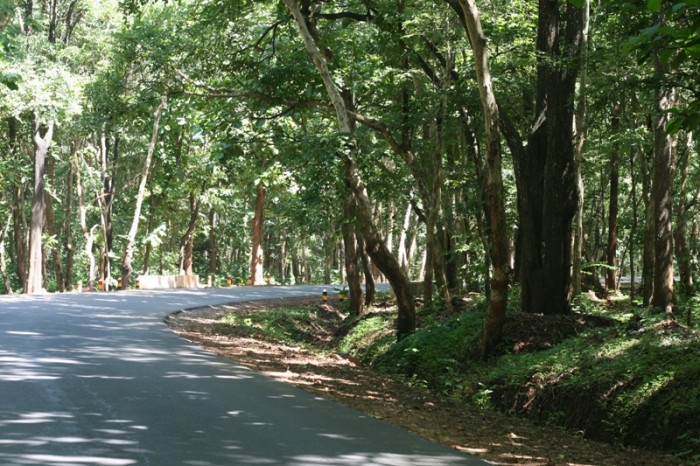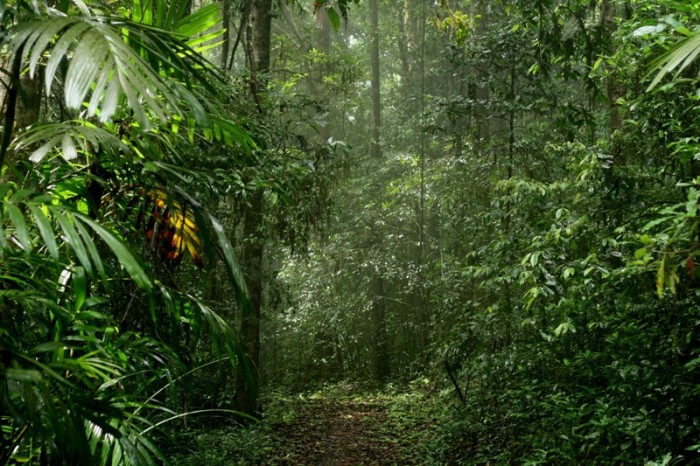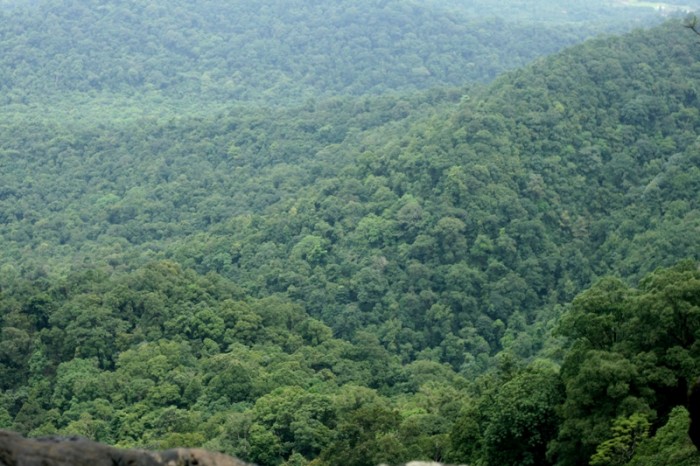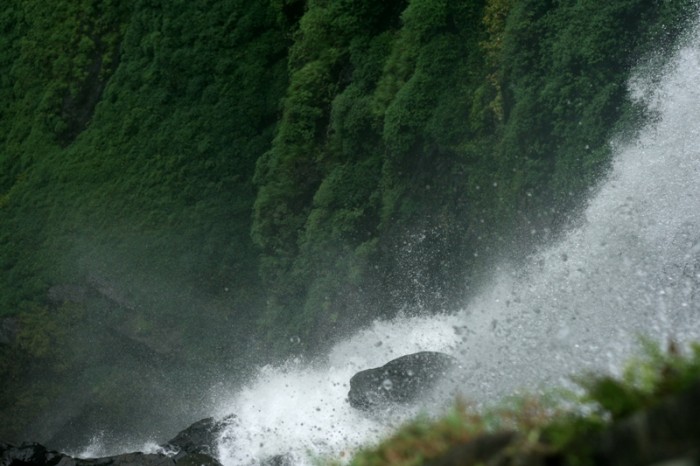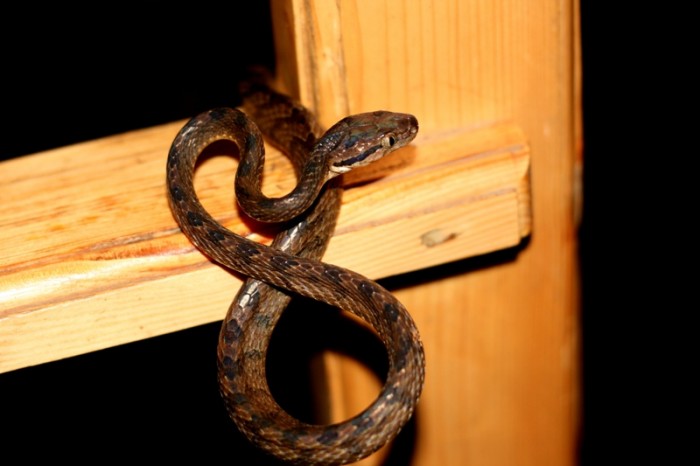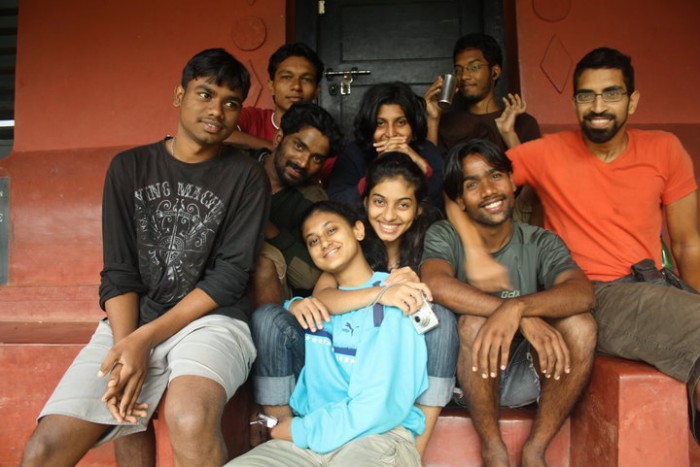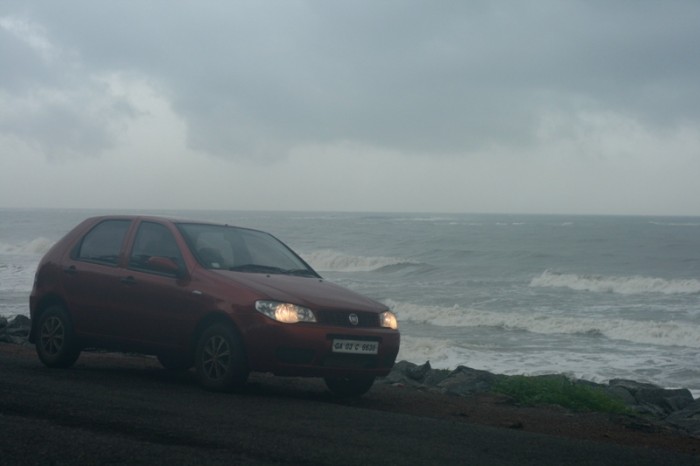Ever since I watched one of Rom Whitaker’s documentaries on the King cobra I’ve wanted to go to Agumbe. Apparently Rom himself had caught his first King Cobra in Agumbe in 1971 and he maintains that Agumbe remains for him the best place for establishing a king cobra sanctuary.
Around 2005, Rom bought four acres in one of the forested patches and started the Agumbe Rainforest Research Station (ARRS). And on 29 June 2010, that’s where I was headed!
I was driving alone since all my friends had bailed out on me. Lucano had just had his second baby, Nitin had a meeting in Bombay, and so on. I got tired of waiting, so I packed my bag, picked up my binoculars, camera and a map of Karnataka and was on my way at 6:30 in the morning.
Over the years, I’ve gone on quite a few trips into the Western Ghats and I absolutely enjoy the drives in the rain. I drove non-stop since I don’t get tired easily driving during the day.
Karnataka has some very picturesque drives and after talking to Wrik (an aquaintance of mine who’s sort of a driving expert on Karnataka) I had decided on taking different routes each way. While going to Agumbe I drove from Parra, Goa along the NH 17 all the way up to Honavar and then turned inland to Shimoga. From Shimoga I turned towards the coast again, and after ten solid hours of driving, I was finally at the ARRS.
I had previously spoke to Chetana who organizes bookings at ARRS. Chetana turned out to be be a young student doing research at the Station and the first evening I landed there she showed me around the property. I absolutely loved the feel of the rainforest. It was cloudy and cool and the air resonated with the sounds of cicadas.
Ten minutes into the walk I was photographing a Malabar pitviper that Chetana had pointed out to me. ‘Oh look’ she exclaimed as I clicked away on my camera. ‘A vine snake on that bush!’ I was already sold on this place!
That night, I was introduced to the other young students and volunteers—Parveen, Sreekar, Damini and Neeti were all students, each doing their own project and helping out at the ARRS. Dhiraj and Ajay tracked the two King Cobras that were tagged with radio chips. They went out everyday and monitored the movements of the giant snakes, where they went, what snakes they ate, etc.
Prashant, a tough looking chap with a french beard and an amicable smile, handled the accounts and the general upkeep of the place. And of course I shouldn’t forget Brian from California who is a replica of the wrestler Steve Austin (only a little smaller!) and who helped me find one Malabar pitviper and a frog that I am yet to identify.
They were a lively, friendly bunch and over the two days I spent there, they opened up to me, not just entertaining me with nightly walks to spot herps but also sharing their chocolates, peanut butter and chicken kebabs with me!
I slept in the dormitory with the rest of them and over the next two days learnt how to eat vegetarian food again. I actually ate lady fingers for the first time in my life!
That night I went for a walk with them and saw five species of frogs—the Golden Frog, the Bronze Frog, the Bi-coloured Frog, the Blue Eyed Bushfrog, and the Malabar Gliding Frog.
Unfortunately I’m not used to night photography at all and in addition my 50 mm Canon lens struggled to focus on the tinier creatures that we saw all around. To make matters even more embarassing Parveen was getting the most mindblowing photographs with her regular tiny idiot-proof camera! I made a mental note to get myself a macro lens when I got back.
The next evening, Sreekar and Parveen accompanied me to a local waterfall where we were hoping to spot some amphibians. The base of the waterfall was accessed by quite a tricky climb downhill. Huge trees had collapsed with the heavy rains and they now blocked some of the path making climbing even more difficult at some spots. It was raining when we set out, and by the time we were at the base of the waterfall the water flowed in torrents. There would be no chance of seeing any amphibians that day.
Parveen gave me a tip on photographing the waterfall though, ‘Slow down the shutter speed to one second and then see the effect’ she said. I didn’t realize what she was talking about till I tried out what she told me. The effect was beautful. The usually sharp features of the water thrashing down the mountain were transformed into a lovely hazy milky flow!
The ARRS does not have an electricity connection. It was Rom’s idea that the Station should be sustainable, so the entire place is only powered by solar panels, which obviously work well as long as its not raining! Considering I was there in the rainiest period of the year, we spent most of the nights in darkness—which was a good thing, because it gave me more reason to take the torch and go outside, instead of just sitting and reading a book in the dorm.
At night, I could hear several species of frogs croaking, each at their own frequency and pitch so as not to summon the female of the wrong species! Neeti pointed out the whistle of the Slender Loris to me. It was a single loud high-pitched whiste. It was one of those things where once someone else identifies it for you, it’s impossible to miss it or confuse it for anything else.
In the day I could hear Hornbills, Pygmy Woodpeckers, possibly Scimitar Babblers and Malabar Giant Squirels. The cicadas continued to call both day and night. There were several Malabar Pitvipers within the property. I myself saw three. And they were all different colour morphs.
The good thing about Malabar Pitvipers is that they tend to sit in the same spot, sometimes for days on end. Which was why when Chetana said to me one morning ‘Rahul, there’s a bright yellow pitviper on the bush near the loos.’ I could say to her ‘Oh, wow! I’ll go and check it out after I have my lunch.’ After lunch it was raining, so I went there after my siesta, and the pitviper was still there. It had not moved an inch!
On my last day at ARRS, Prashant organized for a local tracker to take me on a trek to a waterfall called 1KB. The waterfall was a four kilometer-long trek through leech infested rainforest. Prashant figured that it would take me an hour and a half either way. I wasn’t bothered about the walking—t was the leeches I wasn’t too happy about! It’s not that I was afraid about them sucking my blood (I’ve been bitten by leeches several times before), its just that leech wounds take atleast two to three weeks to heal. And during those two weeks, I would be itching at every bite, which would keep reopening the wounds. Still, they couldn’t be as bad as the tick bites I’d received only a month ago while trekking in Sirsi (also in Karnataka)
The good thing was that while leeches are found in the monsoons, ticks are mostly found in the dry summer months. So this walk was thankfully going to be tick free at least!
I wore leech socks (basically bags of thick material which came all the way to my knees), and wore my shoes over them. The leech socks were Prashant’s idea and I must say I was totally skeptical about their effectiveness at the start. But I figured I’d try them anyways.
My guide Raghu walked barefoot. And even though he was half my size he walked fast. I on the other hand, after a heavy breakfast could only hope that I would not get a cramp matching his speed. Of course my ego wouldn’t allow me to ask Raghu to walk slower, so I resorted to more deceptive tactics. Every once in a while I would grunt (Raghu and I didn’t have a common language) and pretend that I needed to stop to tie my shoelace, or click a photograph of a giant squirell already too far away, or simply pause take in the forest (which was more me trying to breathe deeply so I didn’t give the game away by gasping for air!).
The forest we walked through was dense and dark. There was thick mist in some areas and water dripped constantly from ferns which draped the biggest trees. For every giant tree with huge buttresses, there were hundreds of saplings all tall but extremely skinny. I figured that this might be due to the selective chopping of the giants. Then I realized however that the reason for the spacing out of the giants was because each one of them formed a huge canopy overhead. Obviously they had to be far apart from each other.
And the struggling skinny saplings weren’t unlike struggling gangly adolescent humans, all of them hoping they were in a spot that would allow them to grow into giants themselves one day.
Raghu carried salt for the leeches and he constantly stopped to rub his feet with a cloth packet filled with salt. There were leeches crawling all over his feet but they didn’t seem to bother him too much.The leeches covered my boots too. To my horror I could see a few of them crawl inbetween my laces to disappear into my shoes. But there was not much I could do. If I stopped to take off a shoe, I’d have tens of them crawling all over the rest of me. Raghu helped by rubbing salt on my shoes as well. But there were just too many leeches and in the end I gave up and prayed that my leech socks would keep out most of them.
Even though we walked along a path in the forest, it seemed as though it hadn’t been used atleast for a week if not more. Shrubs were already crowding the path and Vagu carried a chopper that he used to clear the path every now and then.
The trek ended at the summit of a waterfall overlooking an extensive valley filled with trees. It was a most spectacular place: one moment you could see nothing but trees for miles around, and only five seconds later clouds would block out the entire view.
I conveyed to Raghu in sign language that I loved the place, and he must have got the message since he replied with a visible shake of his head, a big toothy smile and and audible grunt!
We had walked under fallen trees, uphill, and downhill millions of steps to get there and my knees had now turned into jelly. On the way back Raghu sensed that I couldn’t walk so fast and he mercifuly slowed his pace. The leeches though remained merciless and attacked with renewed vigor!
Raghu’s legs were now bleeding conspiciously. My leech socks had surprisingly saved me. Though I had several leeches in my shoes not a single one of them had penetrated the socks!
On the way back Raghu suddenly came to half-stop, sounding one of his audible grunts. He pointed at a small snake on the ground. It was unlike anything I had seen before, but I knew it from pictures. It was a shieldtail snake and I was estatic! I took a number of pictues of it. But the snake was too small and I knew I needed a macro lens more than ever. Since we had spotted the snake right next to the ARRS I carried it with me hoping that the gang back there might be able to identify it.
Like me they were pretty excited to see it but just as much in the dark and as far from identifying it! We tried to do a scale count but the snake was too small and kept moving about so in the end we released it.
I left Agumbe early in the morning on the 2 July. This time, I took the coastal road back home. I drove down the ghats to Udupi and from there on, turned north on to NH17. This road was reasonably crowded with traffic and in some areas filled with pot holes. But it turned out to be a good hundred kilometers shorter. I still prefered the route I took while going to Agumbe though. It was definitely much more scenic.
Wrik tells me that Agumbe is just one of many beautiful places to visit in Karnataka. I believe him and I’m raring to go driving back there again!

